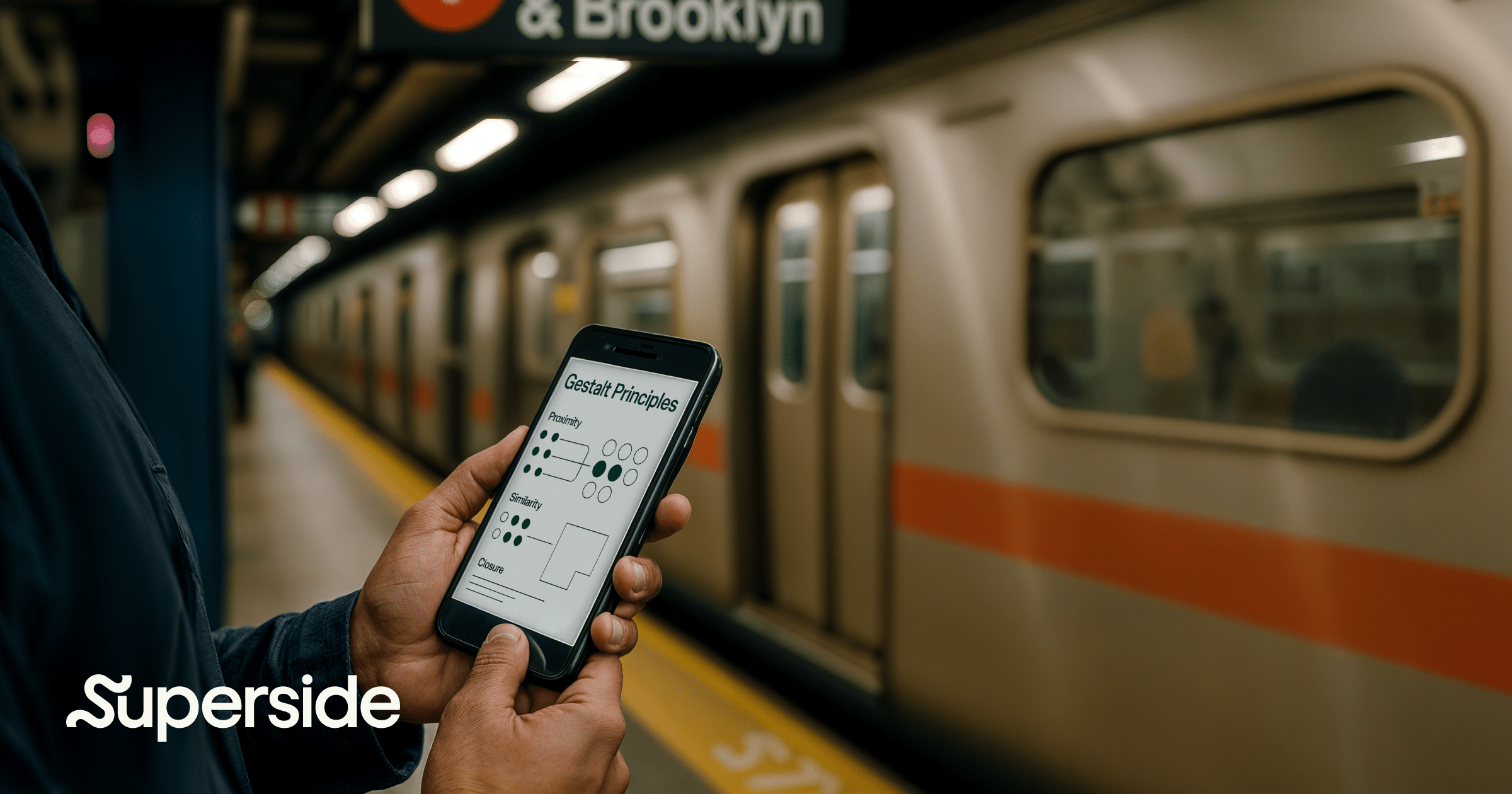
Discover the magic behind designs that just work. Dive into the Gestalt Principles of Design (figure-ground, proximity, similarity, continuity, closure, symmetry, uniform connectedness, parallelism, common fate, focal points and past experience) and learn how to create graphic designs and immersive experiences that captivate, connect and convert.
Some designs instantly draw you in, guide your eye and clearly communicate a message. Others leave you lost in a maze of clutter and confusion. The difference isn’t just color palettes or fonts; it’s in the way our brains instinctively organize and interpret what we see.
Enter the Gestalt Principles of Design: The hidden psychology that shapes how we recognize patterns, group visual elements and quickly make sense of designs. For designers and marketers, the Gestalt principles is the key to creative that’s clear, compelling and persuasive.
Even after a century, these principles remain indispensable. In fact, the ability to organize complex visual information and guide user attention is more critical than ever at a time when immersive experiences, augmented reality (AR) and 3D design become mainstream.
Looking for guidance? As the world’s top AI-enabled, global creative partner for enterprises, the Gestalt principles are design basics our designers nailed long ago. Partner with us, or use this guide to find out how to use these design basics to deliver jaw-dropping creative results.
What is Gestalt psychology?
Gestalt psychology examines how humans instinctively perceive objects and organize the visual world around them. The concept emerged in early 20th-century Germany and was pioneered by Max Wertheimer, Wolfgang Köhler and Kurt Koffka.
The three Gestalt psychologists challenged the prevailing belief that human perception is merely the sum of tiny sensory inputs (almost like pixels that make up an image) and proposed that our minds instinctively organize visual information into patterns, unified wholes and structured forms.
The German word “Gestalt,” often translated as “shape” or “form,” captures the concept that the whole is greater than the sum of its parts.
What does this mean in practice? When you look at a picture or design, you don’t just see random shapes or colors; your brain automatically groups things, notices patterns and forms a complete impression.
Take this light show of Beethoven’s Fifth Symphony, for example. Notice how you don’t see the individual lights and how your brain perceives the whole moving animation at once. This is the Gestalt Principles of Design at work.
What are the Gestalt Principles of Design?
Gestalt started as a psychological theory, but its principles now shape design, art and marketing.
The Gestalt Principles of Design are the common unconscious shortcuts our human brains use to make sense of the visual world around us. This makes them extremely useful for designers and enterprise marketers, who rely on them to convey information faster than would be possible otherwise.
Here’s what Piotr Smietana, Superside’s Director of Brand and Marketing Creative, told us about the importance of these principles in today’s design landscape:
Today, these principles help us understand how people process visual information, which allows us to design effective ads, websites, apps, motion-graphic videos and more.
Different sources list varying numbers of Gestalt principles. We’ve chosen to highlight the 11 most relevant to design. Used together, these principles can make your designs more intuitive, direct user attention and enhance your brand’s visual impact.
The 11 Gestalt Principles of Design with new examples in 2025
In this section, we explore each key principle and reveal how they shape the way people instinctively see and interact with designs.
To keep things practical, not just theoretical, you’ll find real-world examples and clear diagrams to help you bring the Gestalt principles to life.
1. The figure-ground principle
The first Gestalt principle focuses on how our eyes and brain distinguish between figure and ground, i.e., how you separate the main subject (foreground or focal point) from the background in any image or design.
What we focus on becomes the “figure,” while what we overlook fades into the “ground.” Designers and artists often achieve this effect by balancing positive and negative space.
Take the classic optical illusion called “Rubin’s vase,” for example. Some viewers may see two black faces on a white background, while others will see a white vase in the foreground against a black background.
In design, the figure-ground principle can be used to display two messages simultaneously.
The international transportation brand FedEx’s logo is a good example: The negative space between the “E” and “X” forms a subtle arrow that cleverly highlights the brand’s commitment to speed and efficiency.
Another great example is Simon C. Page’s ”Hero and Villain” posters, where figure and ground battle it out for visual attention, just like the hero and villain themselves.
For designers, it’s crucial that key visual elements like CTAs, pop-ups and images stand out clearly from their backgrounds. Naya’s website does this well, as it cleverly places important brand details against inviting scenes of nature and family for maximum impact.
2. Proximity
The Gestalt Principle of Proximity states that we naturally group objects that are close together, while visual elements spaced farther apart are seen as separate.
A practical example is a navigation menu where related links (such as product categories) form distinct groups, as this indicates they belong in the same section.
Furniture giant Ikea does this very well with their web design:
We also associate an icon with its text if they’re placed close together (like the magnifying glass beside a search bar on a website).
In UX design, the Proximity principle is often used to group multiple elements without the use of hard borders. Google Workspace does this well by grouping the various icons for the apps included in Workspace.
For other designers, proximity brings structure and clarity to designs. It guides the viewer’s attention, highlights key elements and helps the design tell a cohesive story.
A great example of the Proximity principle in action is Unilever’s logo, which has many tiny designs placed close together to create a “U.”
3. Similarity
Humans naturally group similar elements to make sense of their surroundings. The Gestalt Principle of Similarity follows from this natural instinct.
This fundamental principle is easy to spot in website navigation menus and other UI/UX design applications.
Designers typically use consistent colors, shapes and fonts to visually connect related functions or categories. Think of eCommerce product tiles: When every tile shares the same size, shape and button style, users instantly recognize they work the same way.
On Zoom’s homepage, for instance, action buttons like “sign up,” “pricing” and “sales” are blue, while informational links such as “resources,” “solutions” and “products” are grey. The color difference subtly signals their distinct functions and guides users through the page.
Etsy’s online shop serves as another great example. Each product block is identical in size and evenly spaced, which creates a clean, unified look. Grouping similar elements helps users quickly spot patterns and relationships and turns a busy page into an intuitive shopping experience.
4. Continuity
According to this principle, humans perceive objects arranged in continuous lines or curves as more related than individual elements on a jagged or broken line. Our eyes are better at following smooth, continuous lines or paths.
If you design multiple elements along curves or lines to guide the user’s eye through the image or layout, the Continuity principle is at work.
The Pinterest feed does this well. Users’ pins are arranged in a flowing, vertical grid that naturally guides the viewer’s eye down the page.
A classic use of the continuity principle is a progress bar or timeline that visually leads the user’s eye smoothly from left to right or top to bottom through each step or phase.
Continuity helps maintain flow and keeps users engaged by creating a clear, unbroken visual journey through information or actions.
On our Superside home page, we apply the Continuity principle to guide our viewers smoothly through various sections of our website.
5. Closure
The Gestalt Principle of Closure proposes that humans tend to perceive an object as complete, even if it isn’t.
For instance, if you draw a dotted circle on a piece of paper and show it to someone, they’ll almost always recognize it as a circle and not just a series of dots. That’s the Closure principle in action. Our brains instinctively fill in the gaps to see a complete shape.
Many famous logos employ the Closure principle. Think IBM, NBC and the WWF logo. In the last example, parts of the panda’s body are incomplete, but we fill them in unconsciously to “see” the complete animal.
The closure principle is also used in web design.
For example, a designer might make half an image visible on a webpage, which unconsciously prompts the user to scroll down and complete the picture. Or they might lean on one element of a brand’s identity (such as color) to get the viewer to fill in the gaps and recognize the brand.
Google’s Doodles are a great example of the Closure principle in action. Instead of always displaying the full Google logo, Google often swaps out or alters letters with playful illustrations, shapes or numbers to draw attention (e.g., they replaced the “o”s with a “2” and “5” for its 25th birthday).
6. Symmetry
This Gestalt Principle of Design taps into our innate desire for balance and order. When elements are symmetrically arranged—whether along a vertical, horizontal or radial axis—they’re perceived as belonging together, forming a cohesive and harmonious whole.
Symmetry gives us a sense of stability and structure. It’s why we find mirrored faces or balanced logos naturally pleasing. Take the MasterCard logo, for example. The two interlocking circles are evenly balanced on either side, creating a clear, stable composition that reads as unified at a glance.
For designers, marketers and creative agencies, symmetry can be a powerful way to create clarity and focus in layouts. It reduces visual noise, enhances recognition, and conveys professionalism.
7. Uniform connectedness
According to this Gestalt principle, objects with a visible connection are perceived as more related than those without any link. When designers use lines, backgrounds, colors or “grouping containers” to visually connect related content, the designs feel more unified and cohesive.
Take New York City’s website. When a user clicks on “NYC resource,” it’s clear which sub-categories belong with that category because they’re all the same blue color.
Additionally, card layouts, such as those on Pinterest or Trello, use uniform connectedness. The content inside each card is visually grouped by a container or background box.
8. Parallelism
This Gestalt principle states that parallel elements are perceived as belonging together, while non-parallel elements appear less connected. This taps into our brain’s natural tendency to spot alignment patterns and group them, even across complex layouts.
While it’s less commonly discussed than the Proximity or Similarity principle, parallelism helps designer maintain visual consistency and facilitate user navigation of large-scale interfaces.
It’s effective to use parallel lines or shapes to indicate relatedness, such as in icon sets or multi-column layouts.
Parallelism is also helpful for organizing large amounts of data or content, as it makes the information feel more structured and less overwhelming. Users can, for example, scan across columns, rows or sections without losing their place.
A popular example in web design is pricing tables with parallel columns that align features and price points. This design element visually reinforces the various offerings.
Beauty brand Birchbox does this well with its subscription pricing.
9. Common fate
While common fate wasn’t part of the original Gestalt Principles of Design, it deserves special attention for its impact on user experience.
The Common Fate principle proposes that individual elements that move or point in the same direction are perceived as a group. They appear more connected than other elements that are still or which move in a different direction.
Think of a flock of birds or a school of fish. The human brain will perceive them as one group rather than individual animals.
In the design world, “common fate” means using motion, or the impression of motion, to guide viewers across designs. You could, for example, align arrows, animations or transitions in the same direction to signal connection or flow.
A common example is the carousel slider, where images or content tiles move in the same direction when swiped or played. It’s clear to the viewer that they form part of a collective set.
Squarespace uses the principle to showcase examples of websites on its homepage.
10. Focal points
According to this Gestalt Principle of Design, elements with strong contrast or uniqueness grab and direct attention. In other words, they become the focal point in a design.
Color, size or placement can help create standout elements that capture attention and guide viewers toward important content or a desired action.
Imagine a call-to-action button in a bright color (e.g., orange or red) on a minimalist white or black landing page. The user’s eye will be drawn directly to the focal point (the button). This could encourage them to take the next step.
Take Hubspot, for example. Their home screen navigation buttons are white, but the “Start free or get demo” button is bright orange. This draws the eye to the on-brand CTA (the focal point), which matches the brand’s colors.
On Beyond’s homepage, the words “reshape industries” are highlighted and used in combination with on-brand shapes to draw viewers’ attention.
11. Past experience
Our last Gestalt principle states that humans interpret visuals based on prior knowledge, learned patterns, cultural backgrounds and past experiences. For instance, when red, orange and yellow appear together, we typically draw on our everyday experiences and associate them with traffic lights.
In design, this means using familiar icons, recognizable patterns or design conventions to help users quickly understand meaning based on what they already know.
Think of the classic shopping cart icon that usually sits in the top-right corner of an eCommerce site. Most internet users will instantly understand its purpose because they’ve seen it many times before.
Apply the Principle of Past Experience thoughtfully since not everyone shares the same background. For example, Microsoft Word’s “save” icon is a floppy disk. This symbol may be unfamiliar to younger users who’ve never used the original technology.
How to use the Gestalt Principles to design better enterprise experiences
Good enterprise-level digital experiences, whether on apps or on-trend websites, go beyond beautiful design. The real challenge is to make complex elements, processes and systems feel simple and easy to understand.
If your enterprise has a massive user base, big datasets and products with complex features, the Gestalt principles can be a lifesaver. They can help you create exceptional yet straightforward designs that guide users smoothly through advanced user journeys, systems or processes.
Core Gestalt principles like proximity, continuity and figure ground can help your enterprise designers organize dense information, establish a clear visual hierarchy and reduce cognitive overload.
Proximity can make it easier for app users to complete tasks. Continuity can lead the eye smoothly through key statistics or facts. And figure-ground can make critical actions or alerts stand out against busy interfaces.
When intentionally applied, the Gestalt principles can reduce friction, improve navigation and boost user engagement across complex environments.
Superside provides comprehensive design services that help enterprise teams across the globe effectively implement these principles. As a subscription-based creative design company, our AI-powered web design and UI/UX services cater to brands in all industries.
Whether you’re a SaaS brand set on doing a web design audit or a financial services company ready to overhaul your app, we can assist.
Gestalt Principles, supercharged by Superside
Over many decades, the Gestalt principles have helped the world’s creative teams create intuitive, effective designs. In 2025, the world’s best campaigns and immersive experiences are still built on them.
Here at Superside, we frequently use all the principles to help ambitious enterprise marketing teams unlock creative excellence at scale. Our globally distributed teams are handpicked from the top 1% of talent, ready to plug directly into your workflows and deliver designs rooted in sound design principles and strategic thinking.
Could your designs work harder? If the answer is “yes,” make Superside your creative team’s creative team.

Roger Match
Content Marketer


















